Impact tests determine the strength and endurance of materials, their fracture rates, and their ability to absorb energy on impact. These tests are conducted to study the behavior of materials under a rapid load, such as an impact. How materials absorb the energy of impacts determines their strength/brittleness characteristics. Brittle materials, such as glass or ceramics, tend to have a lower energy absorption rate and shatter under impact. In contrast, ductile materials such as rubber, copper, or aluminum can absorb a lot of energy without breaking. Therefore, Izod & Charpy impact testing provides an understanding of what a material can withstand before its critical failure. Determining such properties is one of the key factors in choosing materials for the design of new consumer products, as well as for their quality control.
An impact is a powerful force that occurs for a very short time and results in the sudden transfer of momentum and energy to the material under test. The effect of this action is different when the same amount of energy is transferred at a lower speed. Everyday engineering structures are subject to this and can form cracks that eventually propagate to the point of catastrophic failure. Therefore, the golden goal of any mechanical property testing method is to create the conditions that are most relevant to the product use in “real world”.
Impact Testing Application
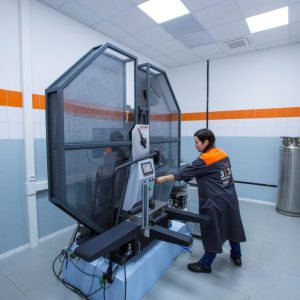 Impact testing can be applied to various types of materials, including metals, plastics, composites, glass, and ceramics. They are most in demand in industries where products are subject to impacts during operation. Examples include the automotive industry, railways, aviation, aerospace, and shipbuilding. Here, strength is key for both the materials used to make the vehicle body and the moving parts of engines and mechanisms.
Impact testing can be applied to various types of materials, including metals, plastics, composites, glass, and ceramics. They are most in demand in industries where products are subject to impacts during operation. Examples include the automotive industry, railways, aviation, aerospace, and shipbuilding. Here, strength is key for both the materials used to make the vehicle body and the moving parts of engines and mechanisms.
Other industries include the military sector, the energy sector, especially turbine production, machine tool building, and the production of working tools. Metallurgy, where the strength of alloys is the basis for all consumer products, is one of the main users of such tests. This also includes other production such as electronics and electrical goods, which may not be supposed to constant impacts during normal use, but their service life depends on the ability to withstand accidental drops and bumps.
Charpy and Izod tests (also known as “notch impact tests”, “notched impact tests” or “V-notch tests”) are two of the most commonly used impact testing methods.
Charpy and Izod Automatic Impact Tests
Both methods utilize an impact pendulum that is raised to a certain height and dropped onto the specimen, striking the material. The pendulum strikes with a constant force, transferring its kinetic energy to the fixed specimen until the specimen is destroyed. Because the sample cannot move, it stores this energy as its own internal energy, which eventually causes it to collapse. Observations of the sample’s behavior using special instruments make it possible to determine the amount of energy absorbed by the sample before fracture. The results are expressed in joules (J).
To ensure the predictability of the fracture location during impact testing, a notch, V-shaped or U-shaped groove is made in the specimen. This helps to ensure an even distribution of stresses and localize the fracture in the notch area. In other words, the sample is weaker in this area, which reduces the risk of accidental fracture in other parts of the sample. This ultimately allows us to create standardized conditions for impact testing.
Therefore, in terms of physical principles, Charpy and Izod tests are almost identical. The difference lies in the standards for the size and shape of the specimens and the localization of the impact.
In the Charpy test, the specimen has the shape of a rectangular bar that is fixed horizontally. The impact is applied to the top surface in the center of the specimen, and the notch is located on the opposite bottom surface, also in the center, where the specimen fractures.
In the Isod impact test, the specimen, also rectangular in shape, is held vertically and the pendulum strikes the side of the specimen where the notch is located, above it. This causes the specimen to fracture due to buckling.
|
Charpy Test |
Izod Test |
|
|
|
|
Metals |
Plastics or Metals |
|
V-notch and U-notch |
V-notch |
|
Specimen Dimensions |
|
|
55 × 2.5 – 10 × 10 mm |
63.5 × 3.0 – 12.7 × 3.2 mm |
|
Specifications |
|
|
ASTM E23, ISO 148, EN 10045-1, MPIF STM 40 |
|
A Historical Overview
In the mid-nineteenth century, the rapid development of railroads, especially in the United States and Europe, prompted researchers to find reasons why unexpected tears and fractures sometimes occurred in metal products. The same effects were observed by other users of metal products used under impact conditions, such as gunsmiths. These manifestations were investigated and it was found that random or cyclic loads on metal can cause it to become brittle. This is how the phenomenon of metal fatigue was invented. Once the destructive phenomenon had a name, many scientists began working to overcome its manifestations. There was an immediate need for a test that could measure the ability of a metal to withstand cyclic loads, and such tests began to appear one after another.
American artillerist and inventor T. J. Rodman created the first drop-weight machine to study and improve the properties of steel for weapons. Drop-weight impact tests are still used today (according to ASTM 7136) to study the impact behavior of components. By the way, the development of impact tests in the military sector has led to the development of a ballistic very high velocity impact tests to study the bulletproof properties of armor (the European EN 1522/1523 and the American ASTM E3062 standards).
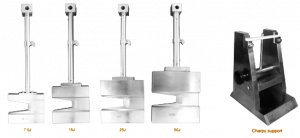 In 1892, the famous French chemist and physicist H. L. Le Chatelier substantiated the use of notched specimens for drop-weight machine testing. The idea was that notching causes brittle fracture of steel even in cases where previous results of unnotched specimens showed ductile behavior. Later, in 1898, the American engineer S. Bent Russel invented a new machine that used a pendulum-shaped hammer.
In 1892, the famous French chemist and physicist H. L. Le Chatelier substantiated the use of notched specimens for drop-weight machine testing. The idea was that notching causes brittle fracture of steel even in cases where previous results of unnotched specimens showed ductile behavior. Later, in 1898, the American engineer S. Bent Russel invented a new machine that used a pendulum-shaped hammer.
At the same time, in 1901, in France, Georges A. A. Charpy used a pendulum device very similar to modern equipment, but the samples he tested were bars with teeth. For the first time, he clearly set out to standardize the test, so he paid much attention to the accuracy of the equipment specification and measurement method and wanted to create a database of test results for materials obtained by one method. The Izod test was developed in parallel by the English engineer Edwin Gilbert Izod and introduced in 1903.
Since then, metallurgists have focused their efforts on creating a standardization of impact tests.
Impact Tests Standardization
In 1922, the American Society for Testing and Materials (ASTM) organized a symposium on impact testing, and 10 years later, the first ASTM E23-33T “Tentative Method of Impact Testing of Metallic Materials” was finally released, specifying the use of a pendulum, both Charpy and Izod, a V-notch specimen, and a measurement system. The standard still exists, although it was revised in 2018. Other standards currently in place are ISO (International Organization for Standardization), EN (European Standard), and MPIF STM (Metal Powder Industries Federation – Standard Test Methods).
During World War II, the United States built a large number of Liberty transport ships to support military operations and cargo transportation. However, after they were commissioned, problems with the reliability and crack resistance of some of these ships were discovered.
The problem was related to the ductile-brittle transition temperature (DBTT) of the steel used to construct the Liberty ships. DBTT is the temperature at which a material changes its mechanical properties from ductile to brittle and becomes vulnerable to cracking and fracture.

It turned out that the steel in the ships had a DBTT close to the freezing point of water. This meant that when operating in cold waters or in winter conditions, the steel became brittle. Since these ships were used in different regions of the world and under different climatic conditions, the material’s brittleness threatened safety and operational capability. In this regard, measures were taken to improve the reliability of Liberty ships. No correlation between brittleness and temperature transition was found in tensile testing, chemical analysis, or microstructure studies. However, impact testing of the steel at different temperatures helped to find this one from DBTT and eventually improve the performance of the structural alloy for ships.
Despite such examples and the importance of steel structures for construction, impact testing is still not included in building specifications and regulations. However, designers are taking into account the importance of impact testing during design, both in terms of energy absorbed and for determining the transition temperature, and this has helped to avoid accidents and damage that could have resulted in deaths and significant economic damage.
Compliance With International Standards
As we mentioned in the historical overview, the creation of standards for impact testing was an important milestone in the development of materials science. Standards define the specifications and requirements for conducting such tests and allow for clear comparison of test results, which is a key factor in both material selection and product quality control.
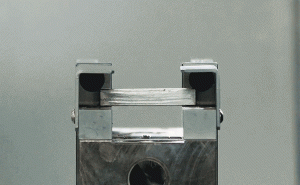
There are a large number of impact test standards for various materials, including plastics, metals, composites, rubber and other materials. Due to the lack of a unified standardization system at the global level, this currently creates certain problems for both manufacturers of consumer products and developers of quality control equipment. The number of impact test standards can be large, ranging from tens to hundreds, depending on the type of material and specifications required in specific industries or manufacturing sectors. Each standard has its own requirements for specimen shape, impact energy, test conditions, and methods for evaluating results.
NextGen equipment is designed to be highly versatile, so that each measuring instrument is able to meet the maximum number of standards without over-complicating the system. This is achieved by using modern technologies and leading engineering thought, no longer by complicating the equipment itself, but by diversifying its modules and replaceable parts. This allows us to expand the scope of testing equipment to meet the largest number of standards.
To perform impact testing in accordance with a specific standard, appropriate equipment and devices must be used. This may include specialized pendulums, fixtures, fasteners, and samples, data logging systems, and other components. That’s why the description of each measuring device on the NextGen website always includes a list of standards to which it complies, so that you can more easily understand the scope and limits of its application.
It is important to keep in mind that the requirements of the standard and the choice of the appropriate equipment depend on the type of material and its application in a particular industry. NextGen’s impact testing professionals are ready to provide all the necessary advice on the standards of methods and equipment required for your work.
What makes Charpy and Izod Tests So Popular?
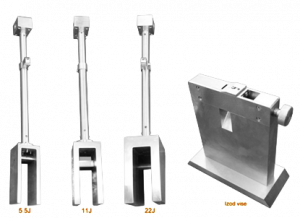 Our historical overview provides a clear picture of the general application of notch tests. They are used to test the strength of different materials under the same conditions, or to test the same material depending on the surface treatment, in product quality control, or depending on the temperature of the sample to determine its ductile to brittle transition temperature (DBTT).
Our historical overview provides a clear picture of the general application of notch tests. They are used to test the strength of different materials under the same conditions, or to test the same material depending on the surface treatment, in product quality control, or depending on the temperature of the sample to determine its ductile to brittle transition temperature (DBTT).
The following most important variables are regulated by the test conditions, which are defined in the standards:
- the specimen shape and dimensions;
- the notchshape and dimensions;
- the impact localization;
- maximum height of the pendulum hammer;
- hammer weight;
- sample temperature.
Among the factors that contribute to the popularity of Charpy and Izod tests, we highlight the following:
- The importance of the characteristics of structural materials to be determined: the ability of materials to absorb energy during impact can be used to determine the impact strength, toughness, fracture resistance and impact resistance of materials, and the fracture mechanism.
- Practicality and simplicity: Charpy and Izod tests are relatively easy to perform and understandable for performers. They do not require sophisticated equipment or special conditions, so they can be performed quickly, providing reliable results, which is ideal for both routine quality control and material selection in new product design.
- Historical reputation: Charpy and Izod tests have proven themselves over the years and have a large amount of scientific research and data to support their effectiveness. This creates trust in these methods among engineers and manufacturers.
Last but not least, there are widely accepted and standardized testing procedures defined by relevant organizations such as ASTM, ISO and EN. This makes it possible to compare the results obtained and makes these methods more acceptable and universal for many industries around the world.
Now we have all the theoretical background to get acquainted with the most modern equipment for conducting Charpy and Izod Impact Tests for various materials at different levels of impact energy.
High Class of Impact Test Systems From NextGen
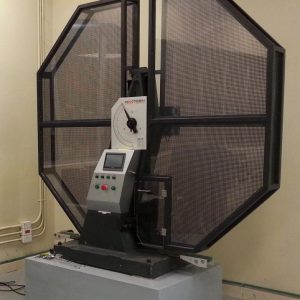 NextGen Material Testing, Inc. is a manufacturer and distributor of material testing and quality control equipment. We work in the North American market to equip small and large laboratories with high-end equipment, along with its installation, service and operational advice.
NextGen Material Testing, Inc. is a manufacturer and distributor of material testing and quality control equipment. We work in the North American market to equip small and large laboratories with high-end equipment, along with its installation, service and operational advice.
- NextGen supplies only state-of-the-art, certified equipment to guarantee accurate results, ease and reliability in operation for an adequate price.
- Instant response from professional employees: we understand the client, the desire to find out all the details, and are ready for questions! It is important to us that you make the right choice on the way to creating your dream laboratory.
- We are proud of our reputation, which we have earned in a short period of time by steadfastly following our customer-oriented philosophy.
We also do our best to meet the needs of industrial enterprises, government agencies and educational institutions for the best impact testing systems.
Here is an overview of the NextGen line of equipment that will solve the problem of conducting Charpy and Izod impact tests with impact energies from 1J to 750J.
Combined Charpy / Izod systems – Engineering Success for Convenience and Quality
NextGen takes full advantage of the ability to combine Charpy and Izod tests in one machine. This combination makes it possible to perform both types of tests in accordance with more standards without the need to expand the set of measuring systems.
The technological realization of the idea of creating combined Charpy/Izod testing equipment required overcoming many technical difficulties. The tests have different geometric features. In order to combine them in one unit, it was necessary to develop a special control unit that provides convenient switching between configurations for both types of tests, parameter control and data acquisition, as well as the necessary software. To perform Charpy and Izod tests in the same equipment, it was also necessary to have interchangeable fixtures that allow for convenient and reliable fixation of the appropriate specimens for each test type.
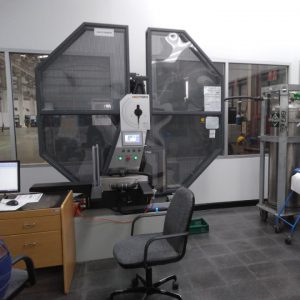
The other need was to take into account the standards and regulations for both tests. This includes specifications for specimen geometry, test conditions, measurement methods, etc.
Finally it was done in collaboration of experts in testing procedures with ones from the fields of mechanical design and automation. Engineers and researchers worked to eliminate potential problems, improve the design, and develop new clamps and switching mechanisms.
The result of this work is NextGen’s line of impact test equipment, which includes combined systems covering the entire range of impact test energies:
- Class J – Charpy and Izod Automatic Impact Testing System – 1J – 50J;
- Class D – Dual Column Charpy Impact Tester – 150J, 300J, 450J, 600J or 750J.
We are proud to introduce these combined test systems to the market, as they are the result of an effective long-term work of engineers and scientists.
This combination makes it possible to efficiently perform impact testing of various materials, ensure the accuracy of the results and maintain the requirements of standards and regulations. Creating such systems was a complex and technically demanding task. Nevertheless, engineering insight and innovation have made it possible to develop this advanced type of equipment that simplifies the testing process and provides a more flexible approach to researching the impact properties of materials.
In general, the combined systems allow you to change the test configuration for testing and easily switch between the two types of Charpy and Izod tests by changing the specimen fixtures, their shape and the system control mode.
The advantages of NextGen’s combined Charpy/Izod test equipment include:
- Space saving: using one piece of equipment for both types of tests reduces the need for separate devices and saves space in the laboratory.
- Save time: there is no need to install and configure separate systems for each type of test.
- Ease of use: operators do not need to master different types of equipment and procedures. All tests can be performed on a single instrument using a single control system.
- Versatility: the ability to perform both types of tests provides more comprehensive quality control of materials, allowing for more information about their impact characteristics.
- Compliance with more standards.
Next, let’s take a brief look at the entire fleet of impact test equipment available from NextGen.
Class J – Charpy and Izod Automatic Impact Testing System – 1J – 50J
The Class J system is a universal solution for impact testing of plastic and rubber samples with both standard Charpy and Izod impact tests. It is possible to use samples in the form of plastic films or sheets. The design of the instrument has been recently improved to enable efficient testing of samples for the Charpy test at energy levels from 1J to 50J and for the lzod test from 1J to 22J.
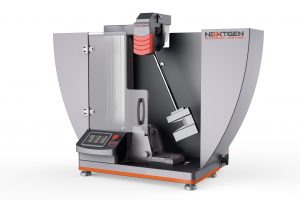
The robust implementation of the Charpy and Izod test combination technology in Class J ensures that tests can be performed to a wide range of standards, which can be found on the product page. Other advantages of the system include its compact size (1000 × 300 × 760 mm), a large impact angle of 150° with an angle measurement accuracy of up to 0.045°, which is ensured by the use of a shaftless encoder that rotates with the pendulum with almost no friction, minimizing the reduction of impact energy. The system is also equipped with a user-friendly touchscreen, software with a simple, intuitive interface, and easy pendulum change and specimen centering.
The system is compatible with the GenChamber multi-temperature test apparatus.
Class D – Dual Column Charpy Impact Tester – 150J, 300J, 450J, 600J or 750J
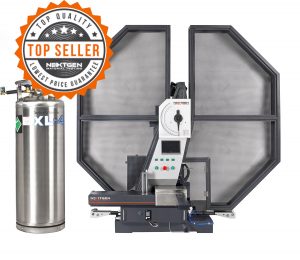 The Class D is undoubtedly the pinnacle of the art of instrument design. Moreover, the Class D is a heavy-duty dual-column impact tester for metals designed specifically for Charpy impact testing. The NextGen Class D is available in two models with maximum capacities of 450J and 750J with interchangeable pendulums for 150J, 300J, 450J, and 600J tests. The safety of these powerful impact systems is also ensured by the physical separation of the instrument’s workspace. The ability to connect to a computer makes it easy to analyze and save test results using our software. The modular design allows users to add automatic sample feeders and a chamber for testing at different temperatures as needed.
The Class D is undoubtedly the pinnacle of the art of instrument design. Moreover, the Class D is a heavy-duty dual-column impact tester for metals designed specifically for Charpy impact testing. The NextGen Class D is available in two models with maximum capacities of 450J and 750J with interchangeable pendulums for 150J, 300J, 450J, and 600J tests. The safety of these powerful impact systems is also ensured by the physical separation of the instrument’s workspace. The ability to connect to a computer makes it easy to analyze and save test results using our software. The modular design allows users to add automatic sample feeders and a chamber for testing at different temperatures as needed.
The system contains many useful features and engineering solutions, which can be found on the product page. But here we would like to note that, given the power of the impact pendulum, the developers paid attention to the safety of its use by creating a completely enclosed impact test area.
Class G – Servo-Motor Single Column Charpy/Izod Impact Tester – 150J, 300J or 450J
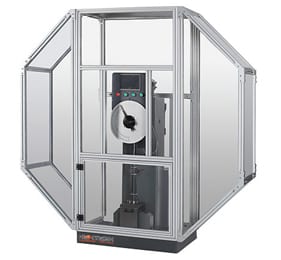 The Class G is engineered for impact testing of metals with the principle of a combined system for Charpy and Izod impact testing. The device is equipped with an impact force sensor placed inside the striker. This improves the measurement accuracy and allows collecting force data at all stages of impact on the specimen and determining the mechanism of its destruction. The possibility of connecting the system to a computer adds to the convenience of using the system in combination with our data management and analysis software.
The Class G is engineered for impact testing of metals with the principle of a combined system for Charpy and Izod impact testing. The device is equipped with an impact force sensor placed inside the striker. This improves the measurement accuracy and allows collecting force data at all stages of impact on the specimen and determining the mechanism of its destruction. The possibility of connecting the system to a computer adds to the convenience of using the system in combination with our data management and analysis software.
For more detailed characteristics of Class G, please visit the product page or create a request, and NextGen consultants will answer all your questions regarding this equipment.
Class H – Servo-Motor Dual Column Charpy Impact Tester – 300J, 450J, 600J or 750J
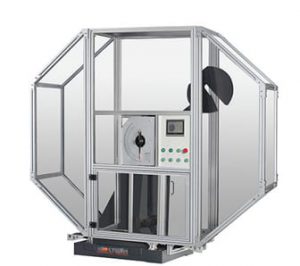 The Class H is a powerful impact tester for metals with a maximum impact energy of 750J. This unit shares many of the advantages of the Class D, but is equipped with a servo motor, which offers the advantage of greater control of the rotational motion and thus more reliable impact test results for the toughest metals. To further expand its research potential, the device can be equipped with a hammer force sensor for precise data acquisition and complete data collection on the failure mechanism of the specimens. The system is designed to perform Charpy impact tests at any preset angle.
The Class H is a powerful impact tester for metals with a maximum impact energy of 750J. This unit shares many of the advantages of the Class D, but is equipped with a servo motor, which offers the advantage of greater control of the rotational motion and thus more reliable impact test results for the toughest metals. To further expand its research potential, the device can be equipped with a hammer force sensor for precise data acquisition and complete data collection on the failure mechanism of the specimens. The system is designed to perform Charpy impact tests at any preset angle.
Additional Equipment
For users of impact testing systems, we recommend that you also pay attention to additional offers from NextGen:
Our consultants are always ready to answer any questions you may have about our products.
In Conclusion
It’s incredible how far humanity has come from the first Rodman’s drop-weight machine to NextGen’s automatic combined Charpy and Izod testing systems. Although it is said that we are only dwarfs and can see better only because we stand on the shoulders of giants, in fact, there are many giants and they stand on each other’s shoulders. And we can see further not only because we stand higher, but also because we strive to see further. We strive to create a new generation of equipment, NextGen equipment.